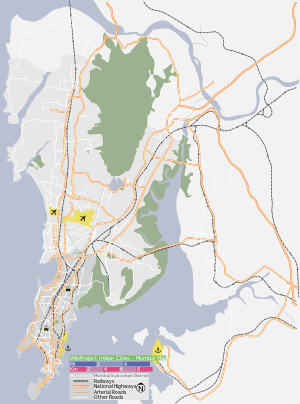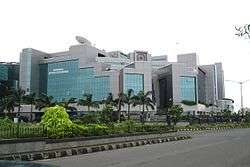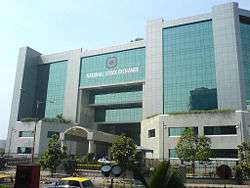National Stock Exchange of India
|
 National Stock Exchange Location of National Stock Exchange in India | |
| Type | Stock exchange |
|---|---|
| Location | Mumbai, India |
| Coordinates | 19°3′37″N 72°51′35″E / 19.06028°N 72.85972°E |
| Founded | 1992 |
| Owner | National Stock Exchange of India Limited |
| Key people | J Ravichandran , Group President (Will be in charge till the board appoints a new CEO) |
| Currency | Indian rupee (₹) |
| No. of listings | 1,696 |
| Market cap | US$1.41 trillion (March 2016)[1] |
| Volume | US$442 billion (June 2014) |
| Indices |
CNX Nifty CNX Nifty Junior CNX 500 |
| Website |
www |

The National Stock Exchange of India Limited (NSE) is the leading stock exchange of India, located in Mumbai.NSE was established in 1992 as the first demutualized electronic exchange in the country. NSE was the first exchange in the country to provide a modern, fully automated screen-based electronic trading system which offered easy trading facility to the investors spread across the length and breadth of the country.
National Stock Exchange has a total market capitalization of more than US$1.41 trillion, making it the world’s 12th-largest stock exchange as of March 2016.[2] NSE's flagship index, the NIFTY 50, the 51 stock index (50 companies with 51 securities inclusive of DVR), is used extensively by investors in India and around the world as a barometer of the Indian capital markets. However, only about 4% of the Indian economy / GDP is actually derived from the stock exchanges in India.[3]
NSE was set up by a group of leading Indian financial institutions at the behest of the government of India to bring transparency to the Indian capital market. Based on the recommendations laid out by the government committee, NSE has been established with a diversified shareholding comprising domestic and global investors. The key domestic investors include Life Insurance Corporation of India, State Bank of India, IFCI Limited IDFC Limited and Stock Holding Corporation of India Limited. And the key global investors are Gagil FDI Limited, GS Strategic Investments Limited, SAIF II SE Investments Mauritius Limited, Aranda Investments (Mauritius) Pte Limited and PI Opportunities Fund I.[4]
NSE offers trading, clearing and settlement services in equity, equity derivatives, debt and currency derivatives segments. It is the first exchange in India to introduce electronic trading facility thus connecting together the investor base of the entire country. NSE has 2500 VSATs and 3000 leased lines spread over more than 2000 cities across India.
The exchange was incorporated in 1992 as a tax-paying company and was recognized as a stock exchange in 1993 under the Securities Contracts (Regulation) Act, 1956, when P. V. Narasimha Rao was the Prime Minister of India and Manmohan Singh was the Finance Minister. NSE commenced operations in the Wholesale Debt Market (WDM) segment in June 1994. The capital market (equities) segment of the NSE commenced operations in November 1994, while operations in the derivatives segment commenced in June 2000.
Unlike countries like the United States where nearly 70% of the GDP is derived from larger companies and the corporate sector, the corporate sector in India accounts for only 12-14% of the national GDP (as of October 2016). Of these only 7,800 companies are listed of which only 4000 trade on the stock exchanges at BSE and NSE. Hence the stocks trading at the BSE and NSE account for only around 4% of the Indian economy, which derives most of its income related activity from the so called unorganized sector and households.[3]
How NSE brought about a paradigm shift in Financial market
NSE was mainly set up to bring in transparency in the markets. Instead of trading membership being confined to a group of brokers, NSE ensured that anyone who was qualified, experienced and met minimum financial requirements was allowed to trade. In this context, NSE was ahead of its times when it separated ownership and management in the exchange under SEBI's supervision. The price information which could earlier be accessed only by a handful of people could now be seen by a client in a remote location with the same ease. The paper-based settlement was replaced by electronic depository-based accounts and settlement of trades was always done on time. One of the most critical changes was that a robust risk management system was set in place, so that settlement guarantees could protect investors against broker defaults.
NSE was also instrumental in creating the National Securities Depository Limited (NSDL) which allows investors to securely hold and transfer their shares and bonds electronically. It also allows investors to hold and trade in as few as one share or bond. This not only made holding financial instruments convenient but more importantly, eliminated the need for paper certificates and greatly reduced the incidents of forged or fake certificates and fraudulent transactions that had plagued the Indian stock market. The NSDL's security, combined with the transparency, lower transaction prices and efficiency that NSE offered, greatly increased the attractiveness of the Indian stock market to domestic and international investors.
Markets
NSE offers trading in the following segments:
- Equities
- Equities
- Indices
- Mutual Funds
- Exchange Traded Funds
- Initial Public Offerings
- Security Lending and Borrowing Scheme
- Derivatives
- Equity Derivatives (including Global Indices like CNX 500, Dow Jones and FTSE )
- Currency Derivatives
- Interest Rate Futures
- Debt
- Corporate Bonds
- Equity Derivatives
The National Stock Exchange of India Limited (NSE) commenced trading in derivatives with the launch of index futures on 12 June 2000. The futures and options segment of NSE has made a global mark. In the Futures and Options segment, trading in NIFTY 50 Index, NIFTY IT index, NIFTY Bank Index, NIFTY Next 50 index and single stock futures are available. Trading in Mini Nifty Futures & Options and Long term Options on NIFTY 50 are also available. The average daily turnover in the F&O Segment of the Exchange during the financial year April 2013 to March 2014 stood at ₹1.52236 trillion (US$23 billion).
On 29 August 2011, National Stock Exchange launched derivative contracts on the world’s most followed equity indices, the S&P 500 and the Dow Jones Industrial Average. NSE is the first Indian exchange to launch global indices. This is also the first time in the world that futures contracts on the S&P 500 index were introduced and listed on an exchange outside of their home country, USA. The new contracts include futures on both the DJIA and the S&P 500, and options on the S&P 500.
On 3 May 2012, the National Stock exchange launched derivative contracts (futures and options) on FTSE 100, the widely tracked index of the UK equity stock market. This was the first of its kind of an index of the UK equity stock market launched in India. FTSE 100 includes 100 largest UK listed blue chip companies and has given returns of 17.8 per cent on investment over three years. The index constitutes 85.6 per cent of UK’s equity market cap.[5]
On 10 January 2013, the National Stock Exchange signed a letter of intent with the Japan Exchange Group, Inc. (JPX) on preparing for the launch of NIFTY 50 Index futures, a representative stock price index of India, on the Osaka Securities Exchange Co., Ltd. (OSE), a subsidiary of JPX.[6]
Moving forward, both parties will make preparations for the listing of yen-denominated NIFTY 50[7] Index futures by March 2014, the integration date of the derivatives markets of OSE and Tokyo Stock Exchange, Inc. (TSE), a subsidiary of JPX. This is the first time that retail and institutional investors in Japan will be able to take a view on the Indian markets, in addition to current ETFs, in their own currency and in their own time zone. Investors will therefore not face any currency risk, because they will not have to invest in dollar denominated or rupee denominated contracts.
- Currency Derivatives
In August 2008, currency derivatives were introduced in India with the launch of Currency Futures in USD–INR by NSE. It also added currency futures in Euros, Pounds and Yen. The average daily turnover in the F&O Segment of the Exchange on 20 June 2013 stood at ₹419.2616 billion (US$6.2 billion) in futures and ₹273.977 billion (US$4.1 billion) in options, respectively.
- Interest Rate Futures
In December 2013, exchanges in India received approval from market regulator SEBI for launching interest rate futures (IRFs) on a single GOI bond or a basket of bonds that will be cash settled. Market participants have been in favour of the product being cash settled and being available on a single bond. NSE will launch the NSE Bond Futures on 21 January on highly liquid 7.16 percent and 8.83 percent 10-year GOI bonds. Interest Rate Futures were introduced for the first time in India by NSE on 31 August 2009, exactly one year after the launch of Currency Futures. NSE became the first stock exchange to get an approval for interest-rate futures, as recommended by the SEBI-RBI committee.
- Debt Market
On 13 May 2013, NSE launched India's first dedicated debt platform to provide a liquid and transparent trading platform for debt related products.[8]
The Debt segment provides an opportunity to retail investors to invest in corporate bonds on a liquid and transparent exchange platform. It also helps institutions who are holders of corporate bonds. It is an ideal platform to buy and sell at optimum prices and help Corporates to get adequate demand, when they are issuing the bonds.
Trading schedule
Trading on the equities segment takes place on all days of the week (except Saturdays and Sundays and holidays declared by the Exchange in advance). The market timings of the equities segment are:
- (1) Pre-open session
- Order entry & modification Open: 09:00 hrs
- Order entry & modification Close: 09:08 hrs*
*with random closure in last one minute. Pre-open order matching starts immediately after close of pre-open order entry.
- (2) Regular trading session
- Normal/Retail Debt/Limited Physical Market Open: 09:15 hrs
- Normal/Retail Debt/Limited Physical Market Close: 15:30 hrs.
Exchange Traded Funds and Derivatives on National Stock Exchange
The following products are trading on CNX Nifty Index in the Indian and international Market:
- 7 Asset Management Companies have launched exchange-traded funds on CNX Nifty Index which are listed on NSE
- 15 index funds have been launched on CNX Nifty Index
- Unit linked products have been launched on CNX Nifty Index by several insurance companies in India
- World Indices
Derivatives Trading on NIFTY 50 Index:
- Futures and Options trading on CNX Nifty Index
- Trading in NIFTY 50 Index Futures on Singapore Stock Exchange(SGX)
- Trading in NIFTY 50 Index Futures on Chicago Mercantile Exchange(CME)
Technology
NSE’s trading systems, is a state of-the-art application. It has an up time record of 99.99% and processes more than 450 million messages every day with sub millisecond response time.[9]
NSE has taken huge strides in technology in these 20 years. In 1994, when trading started, NSE technology was handling 2 orders a second. This increased to 60 orders a second in 2001. Today NSE can handle 1, 60,000 orders/messages per second, with infinite ability to scale up at short notice on demand, NSE has continuously worked towards ensuring that the settlement cycle comes down. Settlements have always been handled smoothly. The settlement cycle has been reduced from T+3 to T+2/T+1.
Financial Literacy
NSE has collaborated with several universities like Gokhale Institute of Politics & Economics (GIPE), Pune, Bharati Vidyapeeth Deemed University (BVDU), Pune, Guru Gobind Singh Indraprastha University, Delhi, Ravenshaw University of Cuttack and Punjabi University, Patiala, among others to offer MBA and BBA courses. NSE has also provided mock market simulation software called NSE Learn to trade (NLT) to develop investment, trading and portfolio management skills among the students. The simulation software is very similar to the software currently being used by the market professionals and helps students to learn how to trade in the markets.
NSE also conducts online examination and awards certification, under its Certification in Financial Markets (NCFM) programmes.[10] At present, certifications are available in 46 modules, covering different sectors of financial and capital markets, both at the beginner and advanced levels. The list of various modules can be found at the official site of NSE India. In addition, since August 2009, it offered a short-term course called NSE Certified Capital Market Professional (NCCMP).[11] The NCCMP or NSE Certified Capital Market Professional is a 100-hour program for over 3–4 months, conducted at the colleges, and covers theoretical and practical training in subjects related to the capital markets. NCCMP covers subjects like equity markets, debt markets, derivatives, macroeconomics, technical analysis and fundamental analysis. Successful candidates are awarded joint certification from NSE and the concerned.
NSE Vs Moneylife
On 22 July 2015, NSE filed a ₹1 billion (US$15 million) suit against Moneylife.[12] However, on 9 September 2015, the Bombay High Court dismissed the case and fined NSE ₹5 million (US$74,000) in this defamation case against Moneylife (www.moneylife.in).[13] The High Court asked NSE to pay ₹150,000 (US$2,200) to each journalist Debashis Basu and Sucheta Dalal and the remaining ₹4.7 million (US$70,000) to two hospitals. On 8 July 2015, Sucheta Dalal wrote an article on Moneylife alleging that some NSE employees were leaking sensitive data related to high-frequency trading or co-location servers to a select set of market participants so that they could trade faster than their competitors. NSE alleged defamation in the article by Moneylife.
See also
- Companies listed on the National Stock Exchange of India
- List of South Asian stock exchanges
- Mahurat trading
- Clause 49
- Bombay Stock Exchange
References
- ↑ National Stock Exchange of India Holidays
- ↑ National Stock Exchange of India Holidays
- 1 2 "National economic debate - Stock markets or rigged casinos - talk by Professor Dr. R. Vaidyanathan (IIM Bangalore) - 21 Jan 2011, Mumbai". www.youtube.com. National Economic Debates.
- ↑ "NSE Shareholding Pattern (For the quarter ended on September 30, 2014)" (PDF). /www.nseindia.com. Narional Stock Exchange of India Limited. Retrieved 7 January 2015.
- ↑
- ↑ UPDATE 1-India's NSE, Japan's JPX plan Nifty futures for Osaka. Reuters. Retrieved on 2013-12-06.
- ↑ https://www.nseindia.com/products/content/equities/indices/broad_indices.htm
- ↑ NSE launches debt trading platform | Business Line. Thehindubusinessline.com (2013-05-13). Retrieved on 2013-12-06.
- ↑ CXO-Dialogue. Moneycontrol.com. Retrieved on 2013-12-06.
- ↑ NSE ties with deemed University to offer pg diploma in financial markets. Edu-Leaders (2012-11-29). Retrieved on 2013-12-06.
- ↑ NCFM(Bhandarkar Road, Pune) - Pune - Maharashtra - India. Puneeducation.in. Retrieved on 2013-12-06.
- ↑ "NSE files Rs 100-cr suit against Moneylife". The Indian Express. 2015-07-22. Retrieved 2015-10-19.
- ↑ "Court fines NSE Rs50 lakh in defamation case against Moneylife". http://www.livemint.com/. Retrieved 2015-10-19. External link in
|website=(help)
External links
| Wikimedia Commons has media related to National Stock Exchange of India. |
Coordinates: 19°3′37″N 72°51′35″E / 19.06028°N 72.85972°E
